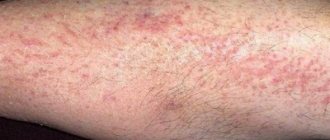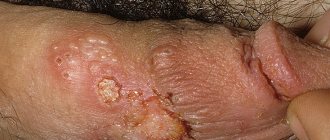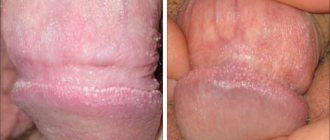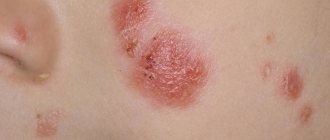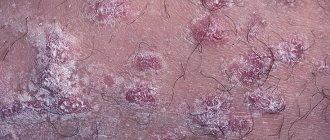Itchy rashes in the genital area are a delicate problem that representatives of the stronger sex are often embarrassed to talk about even with a doctor. Psoriasis on the penis is manifested by redness, itching and flaky plaques that cause physical discomfort. The pathology deals a serious blow to a man’s self-esteem, depriving him of the opportunity to have a full sex life. It is impossible to cure psoriasis once and for all, but achieving stable remission is quite possible.
Etiological factors
Scientists have been struggling for decades to unravel the nature of psoriasis, but they still do not have a clear answer to the question of why this scourge affects people. It is known that this non-infectious disease is not transmitted through household contact, since it is not caused by pathogenic microorganisms, but by the reaction of one’s own immunity.
Under the influence of unfavorable factors, cells of the immune system, responsible for the destruction of pathogenic bacteria and fungi, enter the surface layer of the skin and begin to produce substances that provoke inflammation. The consequence of this process is a pathological increase in the number of keratinocytes through mitotic division. Causes that can cause psoriasis on the penis include:
- Weakening the body's defenses. Since psoriasis is classified as an autoimmune disease, problems with the immune system are a direct path to dermatological pathology.
- Various types of damage to the male genital organ. Under certain circumstances, even a small scratch can trigger the development of the disease.
- Hormonal imbalance. There is a connection between the appearance of skin rashes on the penis and changes in the concentration of androgens in the blood.
- Genetic predisposition. Men whose close relatives were forced to undergo treatment for genital psoriasis are at risk of encountering this problem.
- Psycho-emotional stress and prolonged depression. As you know, many diseases arise against the background of chronic stress. Psoriasis is no exception.
- Malfunctions of the gastrointestinal tract often lead to the appearance of papular rashes on the penis.
- Human habitat. Unfavorable climatic conditions, for example, high humidity, can easily become a trigger for the disease, as well as intensify existing symptoms.
- Diseases of infectious origin that have not been completely cured.
- Chronic pathologies of the pelvic organs.
- Bad habits.
- Unbalanced diet.
- Uncontrolled use of certain medications.
Inguinal psoriasis in women
Psoriasis in the groin in women affects the following areas:
- labia (minor or major);
- buttocks and area around the anus;
- pubis and bikini line; vaginal mucosa.
In women, exacerbations of pathology are often observed during periods of hormonal changes. For example, during menstruation, during pregnancy, during the period after childbirth, and also during menopause. In addition, an attack of the rash can be triggered by poor nutrition, severely restrictive diets, severe stress and hypothermia.
If left untreated, psoriasis can cause vaginitis.
Clinical picture
One of the dominant symptoms of psoriasis on the penis is a bright red rash that covers not only the head and shaft of the organ, but also the inside of the foreskin. Psoriatic plaques covering the penis and scrotum are characterized by thickening and smooth outlines. The spread of the pathological process to the pubic region and groin area is associated with the lack of timely therapy.
Multiple rashes are accompanied by itching, burning, swelling and pain. In men with an advanced form of psoriasis, long-lasting erosions and weeping cracks form on areas of inflammation. During periods of exacerbation, which usually occur in the cold season, body temperature may rise to subfebrile levels.
A considerable percentage of men suffering from psoriasis are exposed to various psychological disorders, which affects social adaptation. About a third of patients note a noticeable deterioration in the quality of life, and issues related to the sexual sphere often come to the fore.
Due to the inability to have sexual intercourse, testosterone levels begin to fall inexorably, and this, as recent research shows, negatively affects the condition of a man’s skin.
Symptoms of psoriasis in the groin
Key external manifestations of the disease:
- rashes that rise slightly above the skin;
- red, pinkish or purple undertone of formations;
- silvery coating on top of the rash (peeling);
- red color of the boundaries of formations;
- mild swelling of areas with rash;
- itching and burning (not always).
The diameter of individual formations varies from 3 to 20 mm. Usually, inguinal psoriasis is most severe in men; photographs of symptoms will help to verify this.
With increased sweating, peeling may not occur. Cracks may form in fold areas. Rashes also often affect the armpits and areas of skin under the breasts.
Often spots can appear on other parts of the body.
Stages of the pathological process
The severity of clinical manifestations of psoriasis in the intimate area depends on the degree of neglect of the pathology. During the course of a dermatological disease, 3 stages are clearly visible:
- Progressive. Small nodular rashes covered with gray scales suddenly appear on the penis. As the rash grows, it forms large plaques. The man complains of severe itching and pain. At the very beginning of the disease, a secondary infection cannot be ruled out.
- Stationary. After some time, it may seem that the disease has completely receded, since new papules no longer appear, and the old ones become covered with crusts. The inflammatory reaction gradually subsides.
- Regressive. At the final stage of the disease, plaques become less noticeable. Soon, in their place only areas of slightly depigmented epidermis remain, but this does not indicate complete recovery. The entire cycle can repeat at any time.
Psoriasis in the groin in men
Psoriasis in the groin in men has a number of features on which the entire treatment may depend.
The following areas are usually affected by the rash:
- penis head;
- pubis;
- testicles; buttocks and perineal area;
- area around the anus.
The disease can lead to the formation of bloody impurities in the sperm and impaired potency. If localized on the head of the penis, complications in the form of balanoposthitis (an inflammatory process in the inner region of the foreskin) are possible.
Photos of symptoms of psoriasis in the groin in men are available in large quantities on the Internet.
Diagnostic methods
Suspicious rashes on the penis should force a man to show himself to a dermatologist or urologist. A pathology such as genital psoriasis is a fairly common dermatosis, the treatment of which begins only after a comprehensive examination of the patient. To confirm or refute the diagnosis, the doctor is required to carry out a number of diagnostic procedures:
- physical examination;
- collection of anamnestic data;
- conducting a biochemical blood test;
- histological examination of biological material taken from the surface of the affected organ.
It is important to differentiate psoriatic inflammation localized on the genital organ from other diseases (allergic rash, eczema, scabies, lupus erythematosus) that have an identical clinical picture. Most of these diseases can be ruled out by examining the penis.
Principles of treatment
The attending physician, when developing a therapeutic regimen, takes into account the severity of the pathological process and the individual characteristics of the body. In mild cases, it is sufficient to use external agents - ointments and creams. It is imperative to reconsider your lifestyle, including eating habits. In more complex episodes, physical therapy is indicated. Oral medications, including those that place additional stress on the body and pollute it, as well as potent hormonal medications, are extreme measures that are resorted to if other methods of therapy do not give the desired result.
Use of topical agents
The lion's share of medications intended for local treatment of psoriasis is presented in several forms, for example, creams and ointments. As an auxiliary element, any substance with a fatty consistency is taken, which allows the active component to remain on the surface of psoriatic plaques for a long time, affecting the affected skin.
Zinc-containing preparations help restore the barrier function of the epidermis. Ichthyol and naphthalan ointments have a resolving and softening effect, which makes them indispensable in the fight against dermatoses of various origins. Keratolytic agents soften the top layer of psoriatic rashes, accelerating their healing. Hydroxyantrones slow down the division of skin cells, thereby stopping the spread of the pathological process. You can get rid of dry skin with the help of hydrating creams.
Applying ointments containing glucocorticoids to inflamed areas quickly relieves the unpleasant symptoms of psoriasis. The action of hormonal drugs is based on the property of synthetic analogues of steroid hormones to suppress the immune response.
Oral medication
In addition to local agents prescribed for the treatment of psoriasis in men, in which the head of the penis is covered with painful papules, drugs are used in tablet form. These include:
- Antihistamines. Designed to inhibit the allergic reaction and reduce itching.
- Antibiotics. Required when a secondary infection occurs.
- Sedatives. Eliminate anxiety and stress, which could both precede psoriatic lesions and become its consequence.
- Analgesics. They help temporarily relieve pain and burning.
- Multivitamin complexes. They have a general strengthening effect and have a beneficial effect on the condition of the skin.
- Immunosuppressants. They block the pathological immune response to epidermal cells.
- Glucocorticosteroids. They are significantly more effective than topical hormonal ointments, so their use is advisable for extremely severe psoriasis.
Physiotherapeutic procedures
Using ointments and systemic medications alone, it is unlikely that it will be possible to cope with such an insidious disease in a short time. There are many reasons for the occurrence of psoriasis on the head of the penis and they lie mainly in violations of the functional systems of the body. In this regard, doctors strongly recommend not to abandon physiotherapy procedures that improve blood microcirculation in the affected areas of the epidermis and thereby stop inflammation.
The inflamed skin of the penis is exposed to ultraviolet light, magnets, ozone, oxygen, and heat. To achieve a pronounced therapeutic effect, at least 10-15 sessions are required. Sanatorium-resort treatment has a positive effect on the overall course of the disease, allowing it to go into long-term remission.
Traditional medicine recipes
A good addition to basic therapy can be the use of natural remedies that have been proven by more than one generation. speed up skin regeneration, reduce itching and relieve irritation:
- You need to mix 50 g of butter with 2 g of finely chopped propolis. Place the finished mixture in a container, then put on low heat. As soon as the healing agent boils, remove it from the stove, cool and strain through cheesecloth. The medicine should be applied to the affected organ after water procedures.
- Mix crushed calendula and St. John's wort leaves in equal parts with vegetable oil. The mixture is applied to areas of inflammation before bedtime.
- Finely crush the burdock root in a mortar and mix it with Vaseline. The product can be used as a compress.
Most people are mistaken in the belief that traditional methods are absolutely safe for health, but such self-medication has its pitfalls - an allergy to natural components can aggravate the existing picture of the disease, and applying ointments of dubious origin to psoriatic plaques is fraught with the most unpredictable consequences. Before turning to alternative medicine, you should consult your doctor.
Preventive measures
It is not possible to insure yourself one hundred percent against psoriasis of the genital organ. However, if you follow simple advice from doctors, you can minimize the risk of rashes in the intimate area:
- Avoid alcohol. Alcohol-containing products and psoriasis are incompatible things. According to some estimates, people who regularly drink from the bottle have skin problems much more often than those who deny themselves the pleasure of drinking.
- Keep your nerves under control. The skin is an indicator of the state of the nervous system. Learning to manage stress can reduce your likelihood of developing psoriasis.
- Eat properly. People prone to allergies should carefully select products.
- Do not spread infectious diseases. And it is also important to strengthen the immune system and prevent hypothermia.
- Do not use hard washcloths during water procedures, which can damage the integrity of the skin of the penis, and also follow safety rules when using a razor in the intimate area.
- Give preference to underwear made from natural fabrics.
We often hear that psoriasis is not a disease, but a result of lifestyle. There is undoubtedly some truth in this statement.
If a man has been diagnosed with penile psoriasis, he will have to completely reconsider his habits and strictly follow the doctors’ instructions. Psoriasis does not tolerate frivolity - if no measures are taken, the frequency of exacerbations will only increase, and reversing the pathological process will be quite problematic.
Prevention measures and prognosis
When the remission stage is reached, it is important to maintain a stable condition for as long as possible and not provoke an acute course of dermatosis. This requires:
- maintain a healthy lifestyle;
- give up bad habits and eat right;
- maintain personal and intimate hygiene in the groin area;
- avoid stress, overwork, nervous breakdowns;
- promptly treat infectious diseases;
- increase immunity;
- avoid injury to the penis.
This will avoid the occurrence of the disease in its acute, progressive stage, which means new stress and treatment.

